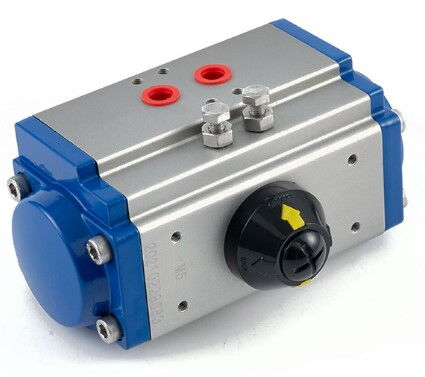Solenoid Valves and Actuators in Industrial Automation
On this page
Solenoid valves and actuators play a critical role in industrial automation control. As execution components, solenoid valves control fluid flow through electromagnetic induction and are widely used for adjusting parameters such as the direction, flow rate, and velocity of gases, liquids, and other media. Actuators, on the other hand, are vital parts of automatic control systems, responsible for receiving signals from controllers and converting them into mechanical motion to adjust controlled variables. This article will provide an in-depth discussion of the structure, working principles, advantages, disadvantages, and applications of solenoid valves and actuators.
A solenoid valve is an automatic device controlled by electromagnetism, primarily used to automate the opening and closing or flow direction control in fluid pipelines. It consists of components such as a solenoid coil, iron core, spring, valve core, and sealing ring. The working principle involves the generation of a magnetic force when the coil is energized, which shifts the valve core to control fluid flow. Upon power loss, the spring force resets the valve core, stopping the fluid flow.

Inside a solenoid valve is a sealed chamber with a piston and electromagnets at both ends. Energizing or de-energizing the electromagnets causes the valve core to move, controlling the opening or closing of oil holes. These holes connect different pipelines, and by adjusting the piston’s displacement, the direction and state of fluid flow are regulated.
The solenoid valve operates in two states: on and off. When the solenoid coil is energized, it generates a magnetic field that overcomes the spring force and separates the valve core from the seat, allowing fluid to flow through. When de-energized, the spring force returns the valve core to the seat, closing the fluid passage.
Excellent sealing: Solenoid valves control fluid flow through an iron core sealed within a magnetic isolation sleeve, eliminating the risk of external leakage, making them ideal for corrosive or toxic media.
Fast response time: The response time can be as short as a few milliseconds, making solenoid valves highly suitable for control systems requiring fast action.
Simple structure: Solenoid valves have a relatively simple design, making installation and maintenance straightforward, with low system costs.
Low energy consumption: With proper design, the coil consumes minimal power, and once triggered, the valve position remains fixed without the need for continuous power supply.
Limited adjustment capability: Solenoid valves typically have only on and off states, with the valve core in an extreme position, making precise regulation difficult.
High media requirements: Solenoid valves require clean media, and they are unsuitable for particulate or viscous substances.
Specific applications: They are well-suited for rapid response applications but not for high-precision regulation scenarios.
Actuators are key execution components in automatic control systems, receiving control signals from controllers and converting electrical signals into mechanical movement to regulate process parameters such as flow rate. Actuators consist of an execution mechanism, output shaft, limiter, and manual operation mechanism.
Actuators convert control signals into mechanical motion to operate or adjust devices like valves. Depending on the energy source, actuators can be classified into pneumatic, hydraulic, and electric actuators, each with distinct advantages and application areas.
Pneumatic actuators use compressed air as the power source, converting air pressure into displacement or rotation to control valves. They are characterized by their simple structure, reliability, and ease of maintenance, making them widely used in fireproof and explosion-proof environments.
Advantages:
Simple structure: The mechanical components are straightforward, making them easy to maintain.
Environmental adaptability: Pneumatic actuators can function in harsh environments.
High thrust: They generate substantial output force, suitable for applications requiring high driving power.
Disadvantages:
Air supply risk: Double-acting pneumatic actuators cannot reset when air supply fails, while single-acting ones rely on spring return, limiting action speed.
Requires air source: They need a dedicated air supply system, increasing installation costs.

Hydraulic actuators are driven by hydraulic oil and are suitable for high-precision, high-output applications. With smooth transmission, they are ideal for situations requiring high resistance to displacement.
Advantages:
High thrust: Hydraulic actuators provide significant torque and allow precise adjustment.
Smooth transmission: They operate without impact, making them suitable for precise control.
Good explosion-proof performance: As they use hydraulic power, there are no sparks as seen with electrical devices.
Disadvantages:
High cost: Hydraulic actuators require external hydraulic systems, leading to higher initial investment and installation complexity.
Complex maintenance: Hydraulic systems and piping need regular upkeep, making them suitable for large-scale operations.

Electric actuators use electrical power and receive signals from Distributed Control Systems (DCS) to adjust flow rates, pressure, and other process parameters. They are ideal for long-distance signal transmission and centralized control.
Advantages:
Convenient operation: Electrical power is easy to access, and signal transmission is fast.
Precise control: Paired with control instruments, they enable high-precision adjustments.
Simple installation: They do not require complex air or hydraulic systems, making installation and maintenance convenient.
Disadvantages:
Complex structure: Electric actuators have a more intricate design and tend to have higher failure rates.
Limited use in explosive environments: Their application in flammable or explosive settings is restricted.

Actuators are widely used in industries such as petrochemicals, natural gas, and power generation as critical devices for controlling and regulating valves. By receiving control signals, actuators adjust key production parameters such as flow, pressure, and temperature, ensuring that processes operate within preset ranges.
Solenoid valves and actuators are essential components in automation control systems, playing critical roles in fluid control and mechanical motion regulation, respectively. Solenoid valves, with their fast response and simple design, are ideal for applications requiring rapid on-off control. Actuators, powered by various energy sources, provide precise valve adjustment across different environments. Understanding their working principles, advantages, disadvantages, and applications helps in selecting the right equipment to meet specific industrial requirements.

